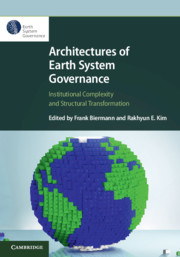Book contents
- Architectures of Earth System Governance
- Series page
- Architectures of Earth System Governance
- Copyright page
- Contents
- Contributors
- Acknowledgements
- 1 Architectures of Earth System Governance
- Part I The Building Blocks
- Part II Core Structural Features
- 6 Institutional Interlinkages
- 7 Regime Complexes
- 8 Governance Fragmentation
- Part III Policy Responses
- Part IV Future Directions
- Glossary
- Index
- References
7 - Regime Complexes
from Part II - Core Structural Features
Published online by Cambridge University Press: 17 April 2020
- Architectures of Earth System Governance
- Series page
- Architectures of Earth System Governance
- Copyright page
- Contents
- Contributors
- Acknowledgements
- 1 Architectures of Earth System Governance
- Part I The Building Blocks
- Part II Core Structural Features
- 6 Institutional Interlinkages
- 7 Regime Complexes
- 8 Governance Fragmentation
- Part III Policy Responses
- Part IV Future Directions
- Glossary
- Index
- References
Summary
This chapter traces the emergence and evolution of the concept of ‘regime complex’. Coined by Kal Raustiala and David Victor in their seminal 2004 article, the term calls anyone who aspires to understand the creation, evolution, implementation or effectiveness of a particular institution to take into account its broader institutional environment. A key innovation in the literature on international institutions, it spawned a rich body of work, rapidly becoming a central element of the theoretical repertoire of global governance. The chapter takes stock of this literature, discussing the main insights on causes, evolution and consequences, as well as the research methodologies that have been used to study regime complexes in various issue-areas of international politics. It also discusses avenues for future research, which may contribute to a deeper and theoretically informed understanding of regime complexity and its implications for global governance.
Keywords
- Type
- Chapter
- Information
- Architectures of Earth System GovernanceInstitutional Complexity and Structural Transformation, pp. 137 - 157Publisher: Cambridge University PressPrint publication year: 2020
References
- 14
- Cited by

